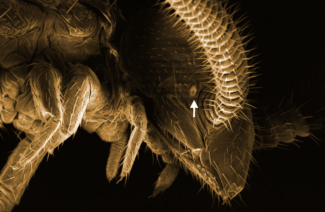
Diego Alberto Salazar Moncada, Jaime Calle-Osorno, Freddy Ruiz-Lopez – Salazar-Moncada DA, Calle-Osorno J, Ruiz-Lopez F (2015) Morphological and molecular study of Symphyla from Colombia. ZooKeys 484: 121-130. doi:10.3897/zookeys.484.8363
“If you enjoy frightening others, you will be reborn as a centipede.”
Zabs-Dkar Tshogs-Drug-Ran-Grol. The Life of Shabkar: The Autobiography of a Tibetan Yogin. Albany: SUNY Press, 1994. p. 295.
I was just doing some light Sunday morning reading, William S. Burroughs and the Dead-End Horror of the Centipede God over in the BoingBoing archives, and it got me thinking. But to get you caught up with where I am in my head, it might take a bit of preliminary work.
Humans are kind of natural-born exceptionalists. We grant ourselves a special position at the top of the hierarchy of life on Earth based on our badassness as predators and raw destructive power … in the face of the evidence that 90% of us will scream like a little girl to find a centipede is sharing our chair with us, and in the face that any serious weather releases more energy than literally millions of our biggest bombs. We grant ourselves the position at the top of the pyramid even though we know that 97% of the inhabitable volume of the skin of our still mostly molten ball of rock is drowned in salt water at pressures that would crush us to jerky-nuggets before we have the luxury of drowning, supporting a huge wealth of life, mostly invertebrates by gross tonnage, that is not us. Meanwhile, on land, we only kind of thrive wedged between deserts and mountains and icy wastes, sandwiched between the sea and sky, outperformed by … grass. Trees. Roaches. Pigeons. Tardigrades. Bats, even. But we’re super-nifty because we got guns and iPhones.
We also have bacon, and cigarettes, and poverty — any one of which is more lethal than any conscious actions humans take to demonstrate their deadliness. As if that’s a valid measure of the value of a species regardless. If we try for a more positive measure, well, none of our largest contributions to Earth will last more than 250 years after the last human dies — and most of it will be gone inside of 50 years. Even the flags planted on the Moon will be bleached white into flags of surrender.
But, well, that’s just a tangent. A little context. We’re not all that, and centipedes are just cousins we kind of lost touch with not long after the Cambrian Explosion. But for all of our kinship, they seem monstrous. Alien. The only thing we respond with more revulsion to are other human beings — the sick, the deformed, the ones just different enough from us to trigger that “is it communicable?” reflex, that “uncanny valley” rejection of just like us, but … off. The reason we feel unease in the presence of too much inbreeding (cue “Dueling Banjos“). The reason there are no other remaining species of genus Homo.
Burroughs wrote in The Place of Dead Roads of people who were “being processed into centipedes. The centipede eyes are already in place. Eventually the centipede will emerge from the forehead, leaving the dead gray hulk behind.“… and that’s what made me think of the centipedes of the mind. That there is a way of thinking of a centipede in such a way that it manifests inside your skull, such that you can feel it climbing the walls of your skull with its needle-feet tickling the inner surface of your meninges, wriggling around aquatically in your cerebrospinal fluid….
And it can be transmissible.
And it can multiply, and divide us humans into opposing populations of infected and … yet to be infected, in which situation both populations see each other as inhabitants of that Uncanny Valley of the diseased. Because once you know about the centipede, even the absence of it leaves it defined in your mind in negative space in such detail that the exact shape of the centipede-hole behaves precisely as the centipede itself, and is also transmissible.
And then the presence or absence of the centipede itself becomes the defining characteristic of a new pair of subspecies of human, seeing as a principal defining characteristic of whether populations are different species is whether they interbreed or, for whatever reason, hold themselves separate from one another.
Once you have your centipede (or anticentipede) fully formed and pricking around in your little rubbery ventricles, the centipede eyes are already in place. Only they’re not really eyes. Well, let’s be accurate. They have eyes, but their eyes aren’t the best in the world. They also have Tömösváry organs, which, frankly, nobody is very clear on what they do, except we’ve known about them since the 1880s. But let’s be honest here as well. The centipede’s evolutionary path has not been idle since Great Uncle Pneumodesmus beat Grandmother Titaalik to shore by about 50 million years back in the Devonian days, and we may still have access to some of his stranger elder and eldritch apparati through their relationship.
But if nothing else, your new centipede senses let you detect the presence or absence of centipedes in the brains of others, do declare them once and for all, friend or foe.
[*]







